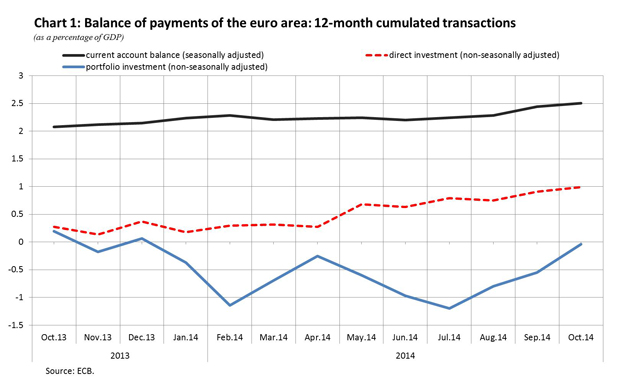Euro area monthly balance of payments (October 2014)
In October 2014, the current account of the euro area recorded a surplus of €20.5 billion. [1]
In the financial account, combined direct and portfolio investment recorded a net increase of €28 billion in assets and a net decrease of €25 billion in liabilities.

Current account
The current account of the euro area recorded a surplus of €20.5 billion in October 2014 (see Table 1). This reflected surpluses for goods (€19.3 billion), services (€5.5 billion) and primary income (€5.3 billion), which were partly offset by a deficit for secondary income (€9.6 billion). [2]
The 12-month cumulated current account for the period ending in October 2014 recorded a surplus of €251.5 billion (2.5% of euro area GDP), compared with one of €205.2 billion (2.1% of euro area GDP) for the 12 months to October 2013 (see Table 1 and Chart 1). The increase in the current account surplus was due mainly to increases in the surpluses for goods (from €210.9 billion to €226.0 billion) and services (from €66.9 billion to €95.2 billion) as well as to a decrease in the deficit for secondary income (from €142.9 to €138.0 billion); these were offset marginally by a decrease in the surplus for primary income (from €70.4 billion to €68.3 billion)
Financial account
In the financial account (see Table 2), combined direct and portfolio investment recorded a net increase of assets of €28 billion and a net decrease of liabilities of €25 billion in October 2014.
Euro area residents recorded a net increase of direct investment abroad (assets) of €11 billion, almost entirely by means of debt instruments (€10 billion). Foreign direct investors increased their investments in the euro area (liabilities) by €10 billion, primarily through equity. As regards portfolio investment, euro area residents made net acquisitions of foreign securities of €16 billion (net acquisitions of debt securities of €27 billion, offset by net disposals of equity securities amounting to €11 billion). On the liabilities side, non-euro area residents engaged in net disinvestments of euro area securities of €35 billion (net disposals of debt securities of €62 billion, partially offset by €27 billion of net acquisitions of equity securities).
The euro area net financial derivatives account (assets minus liabilities) recorded net flows of +€0.2 billion. Other investment recorded net decreases of €34 billion in assets and €14 billion in liabilities. The net decrease of assets was explained by developments in other sectors (€20 billion) and MFIs excluding the Eurosystem (€10 billion). The net decrease of liabilities was primarily explained by developments in the Eurosystem (€8 billion) and MFIs excluding the Eurosystem (€5 billion) sectors.
The Eurosystem’s stock of reserve assets decreased by €11 billion in October 2014 (to €586 billion), which was explained by negative revaluations of €12 billion. Net acquisitions of reserve assets amounted to €1 billion.
In the 12 months to October 2014, combined direct and portfolio investment recorded cumulated net increases of assets by €502 billion and of liabilities by €406 billion, compared with net increases of assets by €845 billion and of liabilities by €799 billion in the 12 months to October 2013. This development resulted from a significant decrease in direct investment activity, which was partially offset by increases in transactions in portfolio investment assets and liabilities
Data revisions
This press release incorporates revisions to the data for the reference periods from October 2012 to September 2014. These revisions have not significantly altered the figures previously published.
Additional information
Time series data: ECB’s Statistical Data Warehouse (SDW).
Methodological information: ECB’s website.
Next press releases: Quarterly balance of payments and international investment position: 13 January 2015 (reference data up to Q3 2014).
For media queries, please contact Stefan Ruhkamp, tel.: +49 69 1344 5057.
Annexes
Table 1: Current account of the euro area
Table 2: Balance of payments of the euro area
-
[1]References to the current account are always to data that are seasonally and working day-adjusted, unless otherwise indicated, whereas references to the capital and financial accounts are to data that are non-seasonally or working day-adjusted.
-
[2]In broad terms, the new concept of “primary income” used in the sixth edition of the IMF’s Balance of Payments and International Investment Position Manual (BPM6) corresponds to the BPM5 concept of “income”, while the BPM6 concept of “secondary income” corresponds to the BPM5 concept of “current transfers”.
Европейска централна банка
Генерална дирекция „Комуникации“
- Sonnemannstrasse 20
- 60314 Frankfurt am Main, Germany
- +49 69 1344 7455
- media@ecb.europa.eu
Възпроизвеждането се разрешава с позоваване на източника.
Данни за контакт за медиите

